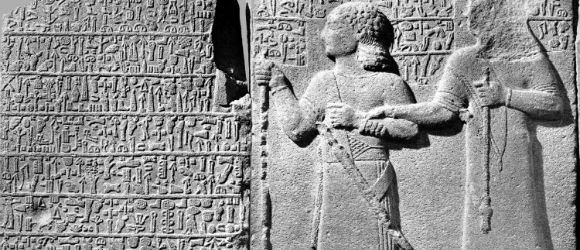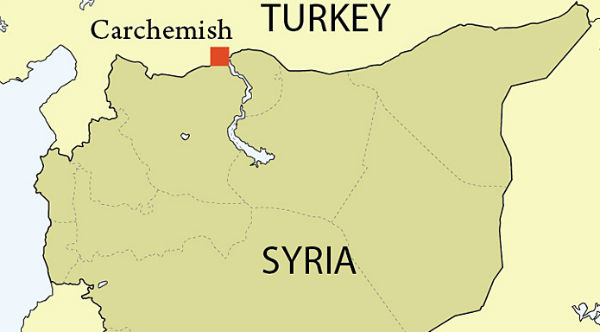Carchemish lies a few kilometers south of Birecik on the Euphrates River. Near the village of Barak on the west bank of the river can be found the few ruins of what was once the capital of one of the most powerful of the Hittite kingdoms.
The site is on the border between Turkey and Syria and therefore guarded by the army. Because of this one must take a soldier with one as guide and guard when visiting it. While Hattusas, the capital of the Hittite Empire, was still functioning (before 1200 B.C.), Carchemish was dependent upon the northern kings. After the fall of Hattusus, Carchemish was a separate kingdom until it was annexed to Assyria in
717 B.C. by Sargon II. The beauty of Carchemish is in its location on the broad Euphrates and in its art work, some of which is now in the Museum of Anatolian Civilizations (Anadolu Medeniyetleri Müzesi) in Ankara. Among the items there are reliefs from a wall celebrating a victorious battle against the Assyrians. A driver holds the reins of horse while an archer shares the platform of the chariot with him and stands poised ready to shoot. Underneath the horse lies a dying enemy. Reliefs illustrating the Gilgamesh epic were also found in Carchemish.
The Hittite people spoke an Indo-European language. The inflections of their nouns closely parallel Latin and Greek, and some of their words are clearly related. For instance, “water” was “watar”, “what” (in Latin, “quid”) was “quit”. The Hittites taught the people of Crete the use of clay tablets for keeping records. They also mined iron.
Charchemish was the scene of the battle between the armies of Pharaoh Necho of Egypt and Nebuchadrezzar. Egypt with her mercenaries from Cush (Sudan), Put (Libya), and Lud (western Turkey) was unable to stand against Babylon. While Pharaoh Necho was passing through Judah on his way to the battle with Nebuchadrezzar at Carchemish, Josiah the king of Judah tried to stop him. Necho told Josiah that he had no quarrel with him, but Josiah insisted on fighting. In the battle at Megiddo Josiah was shot by Egyptian archers and died from the wound (II Chronicles 35:20-25). Necho went on to be defeated by Nebuchadrezzar at Carchemish in 605 B.C.
Carchemish,




Carchemish was strategically located on an important crossing of the Euphrates for caravans engaged in Syrian, Mesopotamian, and Anatolian trade. It was first occupied in the Neolithic period, and pottery finds date back to ca. 3000 BCE. Tombs at Carchemish date back as far as the end of the Early Bronze Age (ca. 2300 BCE).
The first written mention of Carchemish comes from the Mari letters, from the royal archives of Mari, ca. 1800 BCE (contemporary with the Twelfth Dynasty). At that time Carchemish was ruled by a king named Aplahanda and was a center for the timber trade, perhaps engaged in shipping timber from Anatolia down the Euphrates. In the Eighteenth Dynasty, Thutmose I erected a stela near Carchemish, celebrating his victorious campaign into Syria and across the Euphrates. Around the end of the reign of Akhenaten, the Hittite king Suppiluliumas captured Carchemish and established his son Piyassilis (also called Shar-Kushukh) as its king. When the Hittite empire fell to the Sea Peoples, Carchemish probably went with it. In 717 BCE it went to Sargon II of Assyria, and in 605 BCE an important battle was fought there by the Babylonian Nebuchadnezzer II when he expelled the Egyptians from Syria.
The city had thick double walls defending it, with towers and gates. On the citadel were orthostates, or stone slabs set at the bottom of mud-brick walls, that were carved in the eclectic style peculiar to northern Syria. Elements of Assyrian art, possibly brought by Hurrians from northern Syria, were also found at Carchemish.
The patron goddess of Carchemish was Kubaba. She played a minor role in Hittite religious texts, appearing mainly in the context of Hurrian gods and ceremonies. She was represented as a dignified woman wearing a long robe, standing or seated, and holding a mirror. Her name, but none of her other aspects, was later adopted by the Phrygians for their mother-goddess Cybebe (Cybele).
Carchemish is mentioned in the Ebla texts at the end of the Early Bronze Age, and in the letters from Mari in the Middle Bronze II, when it was a dependency of the kingdom of Yamhad (Aleppo). In the 14th century BC, the Hittite king Suppiluliuma I conquered Mitanni and appointed one of his sons as viceroy at Carchemish and another son as ruler in Aleppo. After the fall of the Hittite empire, the Hittite dynastic line continued at Carchemish for several generations into the Neo-Hittite period. It has produced the largest number of Neo-Hittite sculptures and Hieroglyphic Luwian inscriptions from any single site.